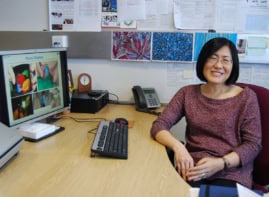
A new type of quasiparticle dubbed the quantum droplet, or “dropleton”, has been identified by researchers in the US and Germany. Created in semiconductor quantum wells using ultrashort laser pulses, the dropleton comprises a small number of electrons and holes that are bound together in a liquid-like drop.
A quasiparticle is a collective excitation within a material that behaves like a fundamental particle. Recently, physicists have identified quasiparticles called levitons, orbitons, phonitons and even wrinklons – which occur in wrinkled fabrics such as curtains.
Bound electrons and holes
The dropleton is related to a well-known quasiparticle called an exciton, which is formed when a semiconductor absorbs a photon. This action promotes an electron from the valence band to the conduction band, leaving behind a positively charged “hole” in the valence band. The electrostatic force binds the electron and the hole together to create an exciton, which moves through the semiconductor like a particle.
More complicated configurations of electrons and holes are known to exist, such as the biexciton, which has two electrons and two holes. Micron-sized droplets comprising many electrons and holes have also been seen in indirect-gap semiconductors such as germanium and silicon. However, these are formed by a thermodynamic process.
Now laser-induced droplets have been created in a direct-gap semiconductor by Steven Cundiff and colleagues at the University of Colorado and NIST in Boulder, and at Philipps-University in Marburg, Germany.
Pump and probe
The researchers create their quantum droplets by firing laser pulses at gallium-arsenide quantum wells. These are 10 nm-thick layers of semiconductor separated by an insulating material. Each pulse “pumps” electrons into the conduction band and is followed by a “probe” laser pulse that is used to measure the absorption spectrum of the quantum wells.
At first, the measurement revealed that the ongoing pumping merely creates more excitons – just as expected. After a while, however, the team found that instead of pairing-up as excitons, the electrons and holes formed unpaired configurations. The result is neutrally charged droplets typically composed of about five electrons and five holes.
Rising pressure
“This transition occurs because of the increasing density of electrons and holes injected by the pump pulses,” explains Cundiff. He adds that the increased numbers of electrons and holes act to screen the electrostatic Coulomb attraction, which normally keeps excitons bound together. Furthermore, he explains that boosting the number of electrons and holes “increases the ‘pressure’ – actually caused by the Fermionic nature of the electrons and holes, and the Pauli exclusion principle – which stabilizes the quantum droplet”.
Once in their new arrangement, the electrons and holes are not fixed in a rigid configuration. Instead, they are able to move around, much like particles within a liquid. It is this behaviour that inspired the team to dub the new quasiparticle a dropleton.
While the quantum droplets might not have any obvious practical applications, the researchers say their discovery could improve our understanding of how electrons interact in solids – and ultimately lead to better electronic devices. Even with their short lifetimes of about 25 ps, the droplets are stable enough to be studied. Cundiff and colleagues are now working to improve their quantum optical-spectroscopy technique, which will allow them to gain a better understanding of the behaviour of the droplets.
Theory and experiment
Jim Wolfe – a physicist at the University of Illinois who was not involved in this study – told physicsworld.com that “The existence of a stable plasma droplet in a photoexcited gallium-arsenide quantum well is a very interesting and novel idea.” He also commends the team for combining “compelling experimental evidence with detailed theoretical support”.
Patrick Parkinson of the University of Oxford also considers the discovery to be important. “This work reports a highly interesting application of their quantum-spectroscopy scheme, both confirming its utility and revealing a previously unexplored many-body quasiparticle within an extremely well-studied material system,” he says. Parkinson adds that he hopes further studies will more fully explore the dropleton’s properties. “In particular, properties arising from its liquid-like pair correlation function are likely to be of great interest,” he says.
The research is described in Nature.



